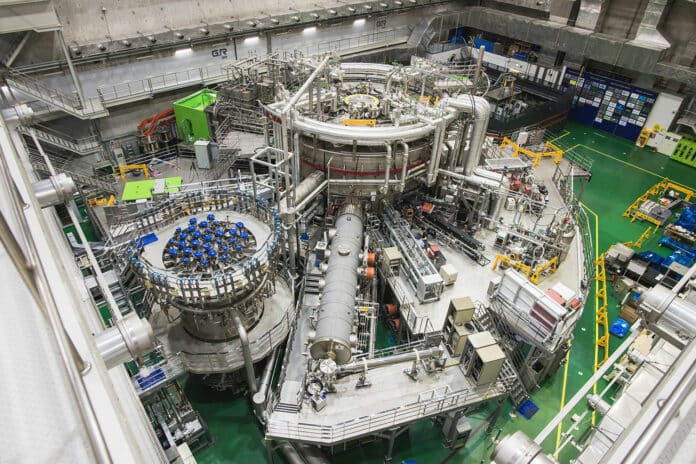The Korea Superconducting Tokamak Advanced Research (KSTAR), a superconducting fusion device also known as the Korean artificial sun, broke its previous plasma operation record during its first plasma campaign after upgrading its divertors, one of the plasma-facing components, to tungsten monoblocks.
According to the Korea Institute of Fusion Energy (KFE), the plasma was successfully sustained with ion temperatures of 100 million degrees Celsius for 48 seconds during the last KSTAR plasma campaign run from December 2023 to February 2024. It also achieved the high confinement mode(H-mode) for over 100 seconds.
Developing fusion energy requires advanced technology to sustain high-temperature and high-density plasmas where fusion reactions occur for longer durations. To achieve this, fusion researchers are carrying out various plasma experiments using fusion devices like KSTAR.
KSTAR is a superconducting tokamak that has been at the forefront of long-pulse plasma operations. In 2018, KSTAR reached a significant milestone by achieving 100 million degree plasma for the first time. Recently, in 2021, KSTAR set a new record by sustaining plasma with an ion temperature of 100 million degrees for 30 seconds. This achievement is a significant step forward in developing sustainable fusion energy.
The KSTAR team was able to extend the operation of ultra-high-temperature plasma to 48 seconds while maintaining an ion temperature of 100 million degrees. It was based on advancements in plasma heating systems and high-temperature plasma operation and control techniques. The plasma duration resulted in a new record in the field of ion temperatures beyond 100 million degrees. Also, the team successfully maintained H-mode for a continuous duration of 102 seconds.
The new tungsten divertors showed only a 25% increase in surface temperature under similar heat loads compared to the previous divertors based on Carbon. This is particularly advantageous for long-pulse high-heating power operations. The KSTAR team carried out experiments to prove the effectiveness of the upgrade and confirmed that key components of KSTAR, such as heating, diagnostic, and control systems, had ensured the system reliability required for prolonged plasma operations.
“Despite being the first experiment run in the environment of the new tungsten diverters, thorough hardware testing and campaign preparation enabled us to achieve results surpassing those of previous KSTAR records in a short period,” said Dr. Si-Woo Yoon, Director of the KSTAR Research Center. “To achieve the ultimate goal of KSTAR operation, we plan to sequentially enhance the performance of heating and current drive devices and also secure the core technologies required for long-pulse high-performance plasma operations.”
aKSTAR’s ultimate goal is to achieve 300 seconds of plasma operation with ion temperatures over 100 million degrees. To accomplish this goal, the KSTAR team has been focusing on essential research areas and improving device performance. This includes installing additional tungsten plasma-facing components and securing real-time feedback control utilizing artificial intelligence technology.
KFE President Dr. Suk Jae Yoo stated that “this research is a green light for acquiring core technologies required for the fusion DEMO reactor” and that “we will do our best to secure core technologies essential for the operation of ITER and the construction of future DEMO reactors.”
